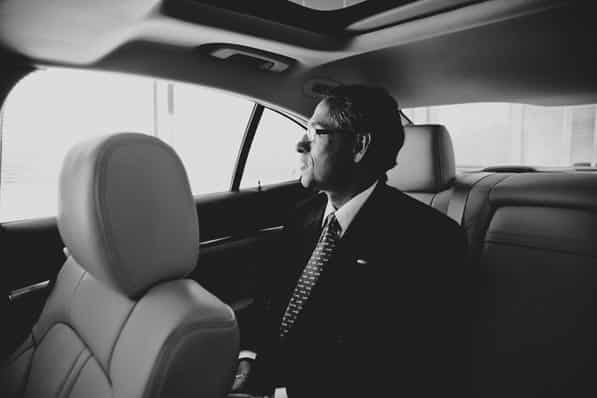Conquering the Open Road
A century-long journey through the models and milestones that have paved the way for Ford’s success
1896
The Quadricycle, built on a buggy frame with four bicycle wheels, is Henry Ford’s first vehicle
1903
Ford Motor Company is founded
1903
The two-cylinder Model A, Ford’s first car, rolls off the assembly line

1908
The Ford Model T is made available to the public. Between 1908 and 1927, 15 million are produced
1917
The first Ford truck, the Model TT, is introduced

1922
Ford acquires the Lincoln brand, bringing the company into the luxury market
1928
The Universal Credit Company marks Ford’s first foray into financing
1942
Ford takes to the skies, gearing up its factories to produce the B-24 Liberator for the US Air Force
1948
The release of the Ford F-Series line embeds the company’s status as a truck maker
1959
Ford Credit is launched to consolidate Ford’s global financing arrangements
1964
The iconic Ford Mustang revs its engine

1970
Ford Pinto is introduced

1972
The Ford Fiera debuts, with the intent of sale in the Phillipines and Asian markets
1981
Ford Escort is introduced in the US
1989
The third generation Ford Fiesta is released in Europe
1991
Here comes the Ford Explorer

1999
In a bid to get into India, Ford develops the Ford IKON, its first car specifically designed for the market
2003
Pop the corks! Ford celebrates its 100th anniversary with the Ford GT

Today
The Ford Focus, EcoSport, and Kuga represent Ford’s bid to redefine itself as a car company with the ability to meet international demand in Asia and Europe



It’s December of 2008. Ford Motor Company CEO Alan Mulally is in front of the Senate Banking Committee on Capitol Hill. While his peers and competitors at GM and Chrysler have asked for $24.9 billion in TARP bailout funds, Mulally is asking for a line of credit. Just two years prior, Ford raised almost $24 billion by mortgaging all of its assets. As a result, the company is far more stable than its Big 3 counterparts. In exchange for the $9 billion, Ford is promising to fast-track the development of hybrid cars, sell companies like Volvo, and increase efficiencies across the board. Doing so will require Ford to change. In fact, the company will never be the same again. It will sell all corporate jets. It will look to global markets. It will undergo a complete and total restructuring.
Five hundred miles northwest, Neil Schloss sits in his office at Ford headquarters, located just outside of Detroit, in Dearborn, Michigan. Schloss, a long-time Ford man, has just accepted a position as vice president and treasurer—the next logical step in his 26-year tenure. At the time, he had little idea how important the treasury’s role would become in transforming an American icon and saving it from the depths of a government bailout endured by its competitors.
Schloss came to Ford in 1982, straight out of San Diego State University. With an undergraduate degree in finance, he moved up the ranks in Ford’s aerospace division while pursuing an MBA. In 1990, Ford Aerospace sold to Loral Corporation, and Schloss accepted his first treasury role with Ford Motor Company. He continued to hone his skills, always with an eye two steps up the ladder. “I never had notions of staying with the company for 30 years,” Schloss says. “I’m a big believer in thinking two to five years ahead, because those are levels you can actually influence.”
Schloss has increased capabilities, responsibilities, and scope in 12 roles since 1991. He became assistant treasurer in 2002 and treasurer in 2007—stepping into the office just as the auto industry entered its downward spiral. The Detroit automakers saw their domestic market share decrease 17 percent from 1998 to 2008. The drop brought with it multibillion-dollar losses in 2005, 2006, and 2007. As oil prices climbed, truck and SUV sales dropped. American plants were forced to decrease manufacturing at a time when global competitors maintained constant output. Ford reduced wages and made layoffs, but continued to invest in products that would hit a market ready for the economic and automotive recovery.
Mulally returned from Washington in 2009 with a renewed focus on the company’s four strategic priorities, called the One Ford Plan. One of those priorities was to finance the plan and improve the balance sheet. While GM and Chrysler were struggling to stay above water, Schloss took drastic steps to get his company on the right financial path. “We implemented a debt restructuring where we offered investors a haircut in combination of cash and the stock,” he explains.
As Schloss watched his two counterparts file for bankruptcy, he bought back $10 billion of unsecured debt for $2.5 billion of cash and $1.4 billion in common stock to restructure Ford’s debt, saving the company more than $500 million in annual interest expense. Additionally, Ford won approval from the United States Department of Energy for $5.9 billion of loans to support the development of more fuel-efficient vehicles. Because of these and other actions completed by Schloss and his treasury team, they are recognized as one of the best corporate treasury organizations in the world.
Ford’s debt restructuring, along with a 2006 secured credit facility of $24 billion that Mulally calls “the largest home-improvement loan in history,” provided the company with the money it needed to make strategic changes in its operations. Ford continued focusing on executing the four-pronged One Ford plan: aggressively restructuring to operate profitably at the current demand and changing model mix, accelerating development of new products that customers want and value, financing the plan to grow the company’s balance sheet, and working effectively together as one team. With credit in place, Ford was free to move forward with its aggressive targets, which almost immediately began paying dividends.
The company’s results were dramatic. Ford went from losing $5.9 billion in the fourth quarter of 2008 to a full-year net income of $2.7 billion in 2009. The next year, profits increased to $6.6 billion while automotive debt dropped by 43 percent; in addition, 2011 and 2012 both saw profits over $8 billion. Ford ended 2012 with $24.3 billion of gross automotive cash, exceeding debt by $10 billion. The company started 2013 with a profit of $2.1 billion in its 15th consecutive quarter of profitability. Schloss says the numbers come from the combined efforts of a dedicated team. “We’ve seen increases due to what we have been able to do in all facets of the business: designing, building, and selling cars and trucks that our customers value,” he says. “Financing actions at both Ford and Ford Credit helped enable the overall company strategy. As we continue to invest in product, we’ve come out of the crisis leaner and more focused than when we went in.”
With Ford’s brand intact and its vigor renewed, Schloss supported the company’s objectives to grow outside of the United States to maintain long-term success. In 2011, Ford had less than 3 percent market share in China, the world’s largest automotive market. Schloss says that number must change. “We have asked ourselves if we want to be a global player or not, and the answer is yes,” he says.
Ford’s 2011/2012 Sustainability report says the company expects “60–70 percent of our growth in the next 10 years to come from the Asia Pacific and Africa region.” There, Ford employs 19,000 workers in 11 markets—numbers that are increasing as the automaker invests billions of dollars into assembly and engine plants. “Between now and 2015, we will launch 50 new vehicles and power trains in Asia, and 15 cars and SUVs in China alone,” Schloss says. “This is the fastest and largest expansion in more than 50 years for Ford. It is
almost unparalleled.”
Ford has also spent the last decade in Brazil, Argentina, and Turkey. “We asked what we want to be when we grow up,” Schloss says of the decision to push further into global markets, “because we’re no longer content to be a North American truck company with a few cars around the world.” To push Ford’s international trajectory upward, the treasury must build the robust infrastructure required in Asia and other international markets. This means training teams and developing people. It means connecting Ford Credit (the company’s financial-services arm) in all markets to support the sale of cars and trucks. It means understanding and navigating the nuances of global capital markets and their regulatory laws. It means working with bank partners around the world to grow relationships in each region. And, ultimately, it means long-term, big-dollar
investment.
Schloss spends significant time developing treasury employees globally—focusing attention on needs to develop local talent in each market. Asia Pacific is a crucial region, where Ford is in the midst of its fastest and largest manufacturing expansion in 50 years. Last year, the company opened new plants in Thailand and China. It will launch seven more before the end of 2015. Ford Credit is helping Ford Motor Company capture market share as credit is available and dealers see Ford setting itself apart from competitors.
The numbers have Schloss and his colleagues optimistic. Just six months after its launch in China in June 2012, the all-new Ford Focus rocketed to become the most popular nameplate in the country last year. And there is no end in sight. Focus sales are up 114 percent so far this year as Ford now routinely sells more Focuses in China than it does in the United States. As the brand grows in the region, Ford is looking to introduce new products. At the 2013 Shanghai auto show, Ford showed the EcoSport and the Kuga (known as the Escape in North American markets). Following the Kuga’s launch in China, in late February 2013, it went on to sell 10,000 units in both March and April, with the trend expected to continue.
The Kuga appeals to Asian consumers sensitive to high gas prices and attracted to tax breaks for efficient vehicles. With improved technology, the Kuga reduces engine-fuel consumption by 25 percent and offers Eco Mode and an Active Grille Shutter that further cuts consumption. “Global consumers are recognizing that Ford is a great brand. We’re doubling dealers and doing all the right things to develop on an international level,” says Schloss, adding that Ford is about to bring Lincoln, its luxury brand, to China for the first time.
Today, Ford’s market share in the region is 3.6 percent, up from 2.6 at the end of 2012. Wholesale volume is up dramatically, and Mulally has called for 6 percent of the market and 1.5 million vehicles sold in 2015. “It’s a very aggressive target, but when you look at our product pipeline, it is imminently achievable,” Schloss says. “We have had humble beginnings in China, and truthfully, got into the market a little late, but now we are the fastest growing automotive brand in the country.”
With 64 million residents, Thailand represents another major Asia Pacific market. There, Ford’s facilities could produce 800 percent more vehicles than it sells today. With 4 percent of market share, Ford is looking to introduce eco-friendly vehicles. To do so, the company is transforming its South American and European product into a global business, and Schloss’s work both in shaping how Ford Credit grows and keeping banking relationships strong directly influences which financial products Ford is able to offer in emerging markets. “We are oriented around strategic growth more than ever before,” Schloss says. “We’ve gone from a period of survival to an efficient method, and treasury’s involvement in that is very real.”

Although times are tough in Europe, Ford is making strides in that part of the world, too. As Schloss says, Ford’s three pillars across the pond are “increasing One Ford products, improving the brand, and cutting costs.” His company is addressing these issues by closing three facilities, launching 15 new products by 2015, and focusing on the much more profitable retail market instead of fleet sales.
While American automakers are losing money in Europe, Schloss believes the market will eventually rebound. “There is much more work to be done, for sure, but we’re headed in the right direction,” he says, pointing to a $270 million improvement in Europe’s Q1 earnings versus Q4 last year as evidence of progress. Positive signs in Europe also include Ford’s joint venture in Turkey. Additionally, Ford is focused heavily on what the company believes will become Europe’s biggest market in 2014: Russia. Regional capacity should increase by 300 percent to 350,000 over the next three years.
A lot has changed during Schloss’s 31-year tenure at Ford. Inside the Dearborn offices, no changes have been felt more dramatically than those Mulally and the team implemented in 2009. “We now have a very focused strategy, a well-crafted One Ford plan, and a seasoned leadership team that has been together for a long time,” Schloss says. These internal plans and performance against those plans are reviewed weekly so issues are identified and quickly addressed. “Accountability to each other to deliver the plan holds everything together,” Schloss adds. And now that Ford has grown into a global company, its meetings include real-time online feeds from around the world. “We are not regional specific anymore,” says Schloss. “We are a global company.”
The famous logo—Ford’s blue oval—took some dents in 2007 and 2008. Schloss, Ford, and Mulally have spent the last five years polishing that oval back to its previous sheen. Schloss calls his work on the 2009 debt restructuring the “highlight of my career,” an effort that culminated in May of 2012. That’s when Moody’s restored Ford to investment-grade with a second upgrade that took the company from Ba2 to Baa3. Ford had pledged all of Ford’s domestic assets and intellectual property—including the iconic logo—to secure billions of dollars in the 2006 loan package. With Moody’s announcement, which cited restructuring moves that positioned Ford to thrive, the blue oval was back. “Bill [Ford] got on the company loudspeaker, which I’ve never heard of him doing in 30 years,” recalls Schloss. “He announced that the logo was back where it belongs. Ford was back.”
The company had survived, emerging from its trials stronger than before, thanks to the focus and ambition of its leaders and the loyalty, trust, and hard work of 164,000 employees. To celebrate, 500 Ford employees headed out to the company lawn in Dearborn, where, dressed in white and blue, they stood side by side to form the still-celebrated blue oval. With television news choppers hovering above, employees remained on the lawn long after the company photo shoot was completed, not willing to end the celebration. Not surprising, considering his robust travel schedule, Schloss missed the festivities. “I was out of the country meeting with asset managers,” he says. “But trust me, I celebrated the achievement in England by raising a glass of single malt scotch to One Ford.”














